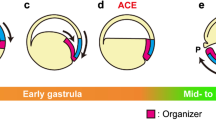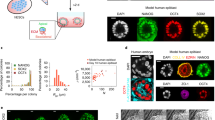Abstract
The blastoderm of the avian embryo acts during the early stages of development as an integrative system programmed to form a single embryonic axis. Isolated parts of the blastoderm are known to each form an axis, owing to the system's properties. In the work reported here, the regulative capability of the right and left halves of chick blastoderms to form an embryonic axis was examined systematically at different stages. This revealed a progressive change in the developing blastoderm. After early separation, the axis in each half will form at some distance from the blastoderm's original midline, while with late separation the axis will form next to the original midline and may even lack one row of somites at the medial rim. Since development stops in culture after about 2 days, axis development after early separation ceases before somites are formed, whereas after late separation somites and brain vesicles can develop. In addition, an attempt was made to learn whether the two halves of blastoderm, when shifted along the midline and then reunited in staggered fashion, act as a single or two separate embryonic fields. When reunion of the right and left halves was achieved so that the posterior end of one half was adjoining the posterior area pellucida region of the other half, a single embryonic axis developed. When, on the other hand, the shift was larger so that the posterior end was fused to the central area pellucida of the other half, two separated embryonic axes developed.
Similar content being viewed by others
References
Azar Y, Eyal-Giladi H (1979) Marginal zone cells, the primitive streak-inducing component of the primary hypoblast in the chick. J Embryol Exp Morphol 52:79–88
De-Robertis EM, Fainsod A, Gout LK, Steinbeisser H (1994) The evolution of vertebrate gastrulation. Development 1994 Suppl: 117–124
Eyal-Giladi H, Kochav S (1976) From cleavage to primitive streak formation: a complementary normal table and a new look at the first stages of the development of the chick. I. General morphology. Dev Biol 49:321–337
Eyal-Giladi H, Debby A, Harel N (1992) The contribution of the marginal zone and Koller's sickle to axis formation in the chick. Development 116:818–830
Hamburger V, Hamilton HL (1951) Stages in the development of the chick embryo. J Morphol 88:49–92
Hatada Y, Stern CD (1994) A fate map of the epiblast of the chick embryo. Development 120:2879–2889
Khaner O (1993) Axis determination in the avian embryo. Curr Top Dev Biol 28:155–180
Khaner O, Eyal-Giladi H (1986) The embryo forming potency of the posterior marginal zone in stage X through XII of the chick. Dev Biol 115:275–281
Khaner O, Eyal-Giladi H (1989) The chick's marginal zone and primitive streak formation. I. Coordinative effect of induction and inhibition. Dev Biol 134:206–214
Khaner O, Mitrani E, Eyal-Giladi H (1985) Developmental potencies of the area opaca and the marginal zone areas of the early chick blastoderms. J Embryol Exp Morphol 89:235–241
Lutz H, Departout M, Hubert J, Pieau C (1963) Contribution à l'ètude de la potentialitè du blastoderm non incube' ches les Oiseaux. Dev Biol 6:23–44
New DAT (1955) A new technique for the cultivation of the chick embryo in vitro. J Embryol Exp Morphol 3:326–331
Rosenquist GC (1966) Autoradiographic study of labeled grafts in the chick blastoderm. Development from primitive streak stages to stage 12. Contrib Embryol 38:71–110
Schoenwolf GC (1992) Cell movement in the epiblast during gastrulation and neurulation in avian embryos. In: Keller R, Clark WH, Griffin F (eds) Gastrulation — Movements, patterns, and molecules. Plenum Press, New York, pp 1–28
Spratt N, Haas H (1960) Integrative mechanisms in development of the early chick blastoderm. I. Regulative potentiality of separated parts. J Exp Zool 145:97–138
Spratt N, Haas H (1961) Integrative mechanisms in development of the early chick blastoderm. II. Role of morphogenetic movements and regenerative growth in synthetic and topographically disarranged blastoderms. J Exp Zool 147:57–94
Author information
Authors and Affiliations
Rights and permissions
About this article
Cite this article
Khaner, O. Axis formation in half blastoderms of the chick: Stage at separation and the relative positions of fused halves influence axis development. Roux's Arch Dev Biol 205, 364–370 (1996). https://doi.org/10.1007/BF00377216
Received:
Accepted:
Issue Date:
DOI: https://doi.org/10.1007/BF00377216




